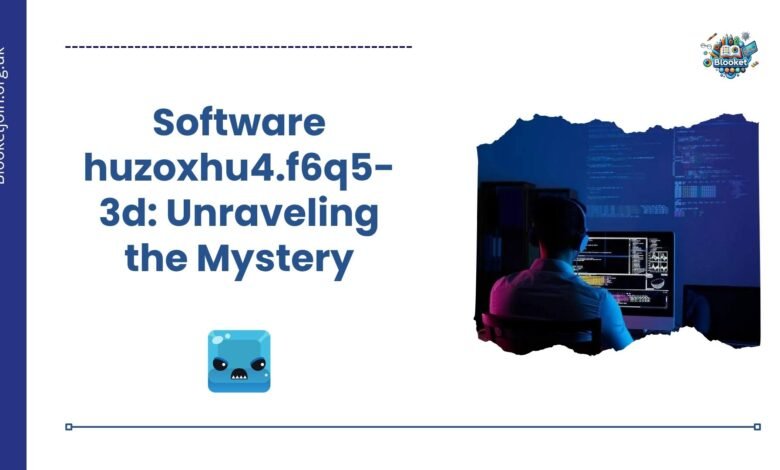Software huzoxhu4.f6q5-3d: Decoding the Enigma Behind the Name

Software huzoxhu4.f6q5-3d is a term that has appeared online, sparking curiosity and speculation due to its unusual, technical-sounding name. It does not refer to a widely recognized or officially documented software application, but rather an ambiguous identifier that has led to discussions about its potential nature, ranging from a hypothetical 3D design tool or data processing program to a mere placeholder or even a deceptive file name.
Software huzoxhu4.f6q5-3d: Decoding the Enigma Behind the Name
What is Software huzoxhu4.f6q5-3d? Understanding the Term’s Origin
In the vast and often perplexing digital world, certain terms emerge that capture public curiosity without clear definition. “Software huzoxhu4.f6q5-3d” is one such phrase. Unlike well-known applications like Microsoft Word or Adobe Photoshop, this term does not correspond to a readily identifiable or officially released software product. Its appearance online has led to widespread speculation and a concerted effort to understand its true nature. The lack of concrete information surrounding it makes it a subject of intrigue, prompting users to search for answers regarding its purpose, origin, and potential implications.
The Ambiguity of the Name: File Identifier, Code, or Placeholder?
The very structure of “huzoxhu4.f6q5-3d” suggests a technical origin, but its exact meaning remains elusive. There are several prevailing theories about what this cryptic sequence might represent:
- File Identifier: It could simply be a unique identifier for a specific file within a larger system, a component of an application, or a part of a software build process. In complex software development, internal file names often use alphanumeric combinations that have no external meaning.
- Internal Code or Project Name: It might be an internal codename for a software project that was never publicly released, a development alias, or a highly specialized tool used within a particular organization. Such names are common in proprietary or highly niche software development.
- Placeholder or Error Message Component: Less likely, but possible, it could be a placeholder name that was not replaced, or part of a system-generated error message.
- Conceptual Term: Some discussions treat it as a conceptual term, perhaps referring to an experimental technology or a theoretical software capability rather than a tangible program.
The absence of a clear, single definition contributes significantly to its mysterious status online.
Why “huzoxhu4.f6q5-3d” is Trending Online
The reason behind the phrase “software huzoxhu4.f6q5-3d” appearing in search queries and online discussions is primarily its unusual and technical appearance. When an unfamiliar term surfaces, especially one that sounds like a piece of software, it naturally triggers curiosity. Users may encounter it in:
- System logs or error reports: Unlikely but possible, if it’s an internal component name.
- Discussion forums: As a point of curiosity or a query from someone who encountered it somewhere.
- Malware reports: Sometimes, malicious software uses obscure or random-looking names to evade detection or to confuse users. This is a significant concern that drives searches.
- Speculative articles: As online content creators attempt to address trending but undefined terms, they might contribute to its search volume.
This collective curiosity and the potential for it to be something important (or dangerous) fuel its presence in online searches.
Lack of Official Documentation and Recognized Developers
A key characteristic contributing to the ambiguity of “software huzoxhu4.f6q5-3d” is the complete absence of official documentation. There are no developer websites, no official press releases, no user manuals, and no recognized software companies or individuals claiming ownership or development of a product by this name. This distinguishes it sharply from legitimate software, which typically has clear authorship, version history, and support channels. The lack of verifiable information makes it difficult to ascertain its true nature and reinforces the need for caution when encountering such terms.

Interpreting the “f6q5-3d” Suffix: Potential Meaning and Speculations
While the “huzoxhu4” part of the name remains entirely abstract, the “f6q5-3d” suffix has led to more specific interpretations, largely pointing towards a connection with three-dimensional computing.
Hinting at 3D Functionality: Graphics, Modeling, or Simulation
The most common and plausible speculation revolves around the “3d” component of the suffix. This strongly suggests a link to:
- 3D Graphics: Software involved in rendering, manipulating, or displaying three-dimensional visual content.
- 3D Modeling: Tools used for creating 3D models of objects, characters, or environments.
- 3D Simulation: Programs designed to simulate physical processes, environments, or interactions in a three-dimensional space.
Given this interpretation, it’s possible that “huzoxhu4.f6q5-3d” might refer to a specialized library, a specific module within a larger 3D application, or a component of a high-performance computing system focused on dimensional data.
Data Processing and Advanced Algorithm Theories
Beyond just visual 3D, the combination of alphanumeric characters also hints at complex data processing. “f6q5” could potentially represent a version number, a specific algorithm, or a unique identifier within a data set. This leads to theories that the software might be involved in:
- Complex Data Visualization: Turning large datasets into understandable 3D models or interactive graphs.
- Scientific Computing: Running simulations or processing data in fields like physics, chemistry, or engineering that require three-dimensional analysis.
- Machine Learning/AI: Potentially a component of an AI system that processes multi-dimensional data, common in fields like facial recognition or spatial mapping.
These interpretations move beyond simple graphics into more advanced computational roles.
Immersive Technologies and User Experience Enhancement
The concept of “3D” also aligns with emerging immersive technologies. It’s plausible, though speculative, that “huzoxhu4.f6q5-3d” could be related to:
- Virtual Reality (VR): Software components that help render virtual environments or manage interactions within VR applications.
- Augmented Reality (AR): Elements that overlay digital information onto the real world, which often requires precise 3D mapping and tracking.
- Enhanced User Interfaces: Software that creates more interactive and dynamic 3D user experiences beyond traditional 2D displays.
These theories position the term within the cutting-edge of interactive digital environments, though without any concrete evidence.
Alleged Features and Capabilities Attributed to Software huzoxhu4.f6q5-3d
Because “software huzoxhu4.f6q5-3d” lacks an official definition, any discussion of its features is based on speculation, logical deduction from the “3d” suffix, and patterns observed in competitor analyses. These are hypothetical capabilities rather than confirmed facts.
Advanced Data Processing and Analysis Capabilities
If the software were real and related to 3D data, it would likely possess strong data processing capabilities. This could include:
- High-Speed Data Ingestion: Ability to rapidly import large volumes of data.
- Complex Algorithmic Execution: Running sophisticated mathematical models or simulations efficiently.
- Multi-Dimensional Data Handling: Processing data points across multiple axes, crucial for 3D environments.
This suggests a tool for researchers, engineers, or analysts working with intricate datasets.
Intuitive User Interface Design Claims
Some speculation hints at an intuitive user interface, which would be essential for complex 3D or data analysis software to be user-friendly. This would imply features like:
- Graphical Representation: Easy visualization of data or 3D models.
- Drag-and-Drop Functionality: Simplifying complex operations.
- Customizable Workflows: Adapting to individual user preferences and tasks.
An intuitive design would make such a powerful tool accessible to a broader range of users.
Integrated Security Frameworks (Encryption, Access Control)
For any advanced software, especially one potentially handling sensitive data or operating in complex environments, integrated security features would be paramount. This might include:
- Data Encryption: Protecting information from unauthorized access.
- Access Control: Managing user permissions and restricting functionality.
- Secure Communication Protocols: Ensuring safe data exchange with other systems.
These hypothetical security measures would be crucial for maintaining data integrity and user privacy.
Customizable Integration Options and Adaptability
A truly powerful piece of software often boasts high adaptability. If “huzoxhu4.f6q5-3d” were a versatile tool, it might offer:
- API (Application Programming Interface) Access: Allowing developers to integrate its functionalities into other applications.
- Plugin Support: Extending its capabilities through third-party add-ons.
- Cross-Platform Compatibility: Running on different operating systems (Windows, macOS, Linux) or hardware configurations.
Such features would make it a flexible asset for various computing environments.
Potential Applications and Industry Use Cases
Based on the speculative features, if “software huzoxhu4.f6q5-3d” were a real and capable piece of software, it could theoretically find applications across numerous industries that deal with complex data, visualization, or simulation.
Healthcare: Advanced Imaging and Diagnostics
In healthcare, such software could be instrumental in:
- Medical Imaging: Processing and rendering 3D images from MRI, CT, or X-ray scans for more precise diagnostics.
- Surgical Planning: Simulating complex surgical procedures in a 3D environment before actual operation.
- Drug Discovery: Visualizing molecular structures and their interactions in 3D.
Manufacturing: Design, Prototyping, and Production Streamlining
The manufacturing sector could leverage such a tool for:
- CAD/CAM Integration: Advanced computer-aided design and manufacturing.
- Virtual Prototyping: Creating and testing product prototypes in a virtual 3D space, reducing physical costs.
- Process Simulation: Optimizing assembly lines or factory layouts through 3D simulations.
Entertainment: Virtual Reality (VR) and Augmented Reality (AR)
The “3d” suffix directly points to the potential use in immersive entertainment:
- Game Development: Creating detailed 3D assets, environments, and physics for video games.
- VR/AR Content Creation: Building realistic virtual worlds or enhancing real-world views with augmented digital overlays.
- Special Effects: Generating complex visual effects for film and animation.
Education: Interactive Learning Modules
In education, “software huzoxhu4.f6q5-3d” could revolutionize learning by enabling:
- Interactive 3D Models: Students could explore anatomical structures, historical sites, or complex machinery in three dimensions.
- Simulation-Based Learning: Providing virtual labs for scientific experiments or engineering challenges.
- Enhanced Visualization: Making abstract concepts more tangible through 3D representations.
General Automation and System Integration
Beyond specific industries, the software might contribute to broader automation efforts:
- Robotics Simulation: Testing robot movements and interactions in a virtual 3D environment.
- Smart City Planning: Modeling urban development and traffic flows in 3D.
- Complex System Management: Visualizing and controlling intricate networked systems in a more intuitive 3D interface.
Risks, Concerns, and Safety Implications of Unknown Software
While the speculation around “software huzoxhu4.f6q5-3d” can be interesting, the most critical aspect when encountering any unknown software is the potential for significant risks. Without official information or a verified source, caution is paramount.
Potential for Malware, Viruses, or Spyware
The biggest threat from an undefined software like “huzoxhu4.f6q5-3d” is the possibility that it could be malicious. Unknown executables or files found online might contain:
- Viruses: Programs that replicate and spread, damaging system files.
- Malware: Broad term for malicious software designed to disrupt, damage, or gain unauthorized access to computer systems.
- Spyware: Software that secretly monitors and collects information about users and their activities.
- Ransomware: Encrypts user data and demands a ransom for its release.
Downloading or executing such files from unverified sources puts your entire system and data at severe risk.
Data Security and Privacy Vulnerabilities
If the software were to be installed, even if not overtly malicious, it could pose significant data security and privacy threats:
- Unauthorized Data Collection: It might silently collect personal information, Browse habits, or sensitive data from your system.
- Open Ports: It could open backdoors in your firewall, making your system vulnerable to external attacks.
- Weak Encryption: If it handles data, weak or absent encryption could expose information to interception.
Protecting your personal and financial data is crucial in the digital age.
System Instability and Compatibility Issues
Even if not malicious, poorly coded or incompatible software can cause severe system problems:
- Crashes and Freezes: Leading to data loss and operational disruption.
- Performance Degradation: Slowing down your computer or interfering with other applications.
- Software Conflicts: Causing other legitimate programs to malfunction.
Without proper testing and quality control from a reputable developer, such issues are highly probable.
Lack of Support, Updates, and Community Resources
A key red flag for “software huzoxhu4.f6q5-3d” is the absence of any support ecosystem. Legitimate software benefits from:
- Developer Support: Channels for bug reports, troubleshooting, and assistance.
- Regular Updates: Patches for security vulnerabilities and performance improvements.
- User Communities: Forums and wikis for shared knowledge and peer support.
Without these, any problems encountered with the software would be unresolvable, leaving users stranded.









